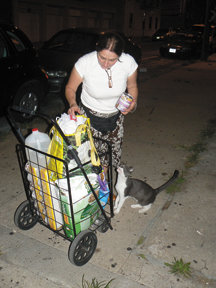Wild, lost, and abandoned animals continue to plague several communities in Hudson County.
Beyond the managerial problems facing shelters and animal control, there are widespread populations of feral cats that hide in the shadows of the night and under the radar of most government and community action.
A few weeks ago, The Reporter broke the news about dozens of cats who were in need of a home before they were scheduled to be removed, and possibly euthanized, from a resident who had been collecting feral cats.
Local volunteers from Weehawken and Union City worked over the course of just a few days to relocate the cats to Secaucus Animal Hospital, which graciously donated their space for the cause.
‘When you see that little face waiting for you, it means the world.’—Ana Mas
________
No money was allocated to the committee and they were to act solely as advisors. Although it’s not clear how much their advice has assisted the feral cat population, several members came to the group with their own ideas and actions on how to fix the problem.
One Union City resident, Tony Squire, conducted a feral cat census earlier this year and collected data.
Another member, Ana Mas, has taken matters into her own “paws” by literally bringing a solution to the streets.
Walking the talk
Though she has lived in Union City for 10 years, Mas said it wasn’t until last year when she was waking up at 3:30 a.m. to go to work that she saw Union City’s feral cats for the first time – they’re known to come out only at night.
Inspired by another resident who introduced her to the “colonies” (clusters wild cats are known to live in), Mas decided to try and make a difference herself.
So every night since then, come rain, sleet, snow, or whatever, Mas has been heading out to the streets along with a cart full of supplies to walk over 20 blocks in her community and feed hundreds of feral cats.
Last week, The Reporter joined her on one of her nighttime excursions to see the problem firsthand.
In just a few blocks distance, dozens of cats peered out from their hiding spaces when they heard the sound of Ana’s cart.
And some especially friendly ones came running out to greet her.
In addition to leaving food and water for the cats, Mas makes it a point to clean up after herself and others by picking up trash on her journey and depositing it into a garbage bag connected to her cart.
Her walks have also become a way of connecting with the community and educating others about the problem.
Mrs. ‘Fix’ it
Mas is often out until past midnight on her journey, and while some passersby are friendly, she admitted that she’s had some strange, sometimes even threatening, encounters with people who do not support her cause.
But she continues on, she said, because of a lifelong love of animals and refusal to turn her back on a problem.
“When you see that little face waiting for you, it means the world,” said Mas. “We have to work together, because they’re not going to disappear.”
Mas said that while there are a lot of people feeding the cats in the city (there are 5 or 6 in her neighborhood alone and many more that feed cats in the parks), spending thousands of their own dollars a month to buy supplies, that’s not a complete solution to actually stop the problem – cats can have kittens nearly every three months, she said.
“The problem is so big,” said Mas. “If everyone spayed or neutered a cat it would help.”
Recently, in just one week alone, Mas brought trapped and brought 15 cats into the veterinarian to be spayed and neutered. In total, she has had approximately 100 cats on Union City’s streets fixed.
Proponents of her method, known as “Trap-Neuter-Release” or “TNR”, say that it is the only proven way to actually control the feral cat population.
And some studies have shown that it is actually more cost effective for a city to have a TNR program than it is to contract animal control services.
But the method is not without controversy of its own.
Some residents in Bayonne who have been dealing with their own feral cat problem have said that feral cats pose a risk to human health and rather than managing the colonies, they should be “removed.”
To weigh in on the feral cat problem in Hudson County, check out this week’s poll at the online version of this story at www.hudsonreporter.com.
How you can help
As economic woes continue, more and more pets are being abandoned to the streets. For more information about the initiatives being done by residents in Union City, visit www.unioncitycares.org.
To find out more about, or to adopt, one of the rescued cats that are temporarily being housed at the Secaucus Animal Hospital, please call (201) 867-4795.
Lana Rose Diaz can be reached at ldiaz@hudsonreporter.com.
Update on Mr. Mangled Paw
Mr. Mangled Paw was a cat found on the street by Union City resident Joyce Fetterman last November.
After a series of miscommunications with the city’s animal services contractor and maze of information about the animals’ future, Fetterman ultimately wound up fostering the cat herself.
Last month, Fetterman sadly informed The Reporter that Mr. Mangled Paw had passed away from illness.
However, she was happy to share that for the final few months of his life he was safe from injury from people, the streets, and lack of food.
And, she said, his life served an even greater purpose for his fellow feline friends.
“As the result of that story, some of us were able to connect to each other,” she said. “And [we have] come together to try and do something about the terrible situation of the feral and stray cats in our town.”
(Poll ends Thursday, Sept. 9.)
